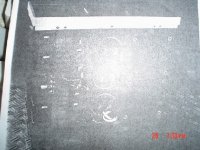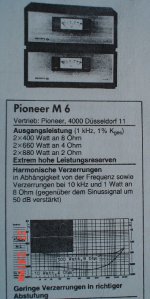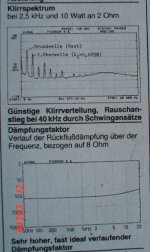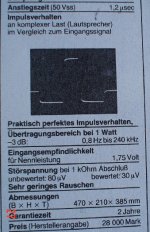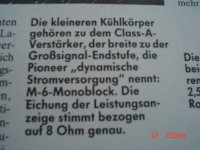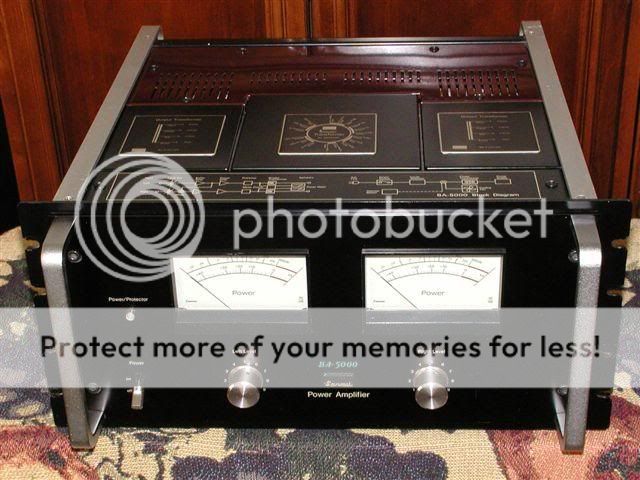Re: Excuses mois monsier Scytales, I am sorry Mr. Scytales
Carlos,
The others are also MT-200 Sankens. (On smaller heatsink) only that they are mounted on their sides so from the top they show only half the width.
Arif
destroyer X said:But watching more close, i could see that power transistors are in the big heatsink, as more usual.
regards,
Carlos
Carlos,
The others are also MT-200 Sankens. (On smaller heatsink) only that they are mounted on their sides so from the top they show only half the width.
Arif
Update time.
I had this M5 confused with one by another japanese company, 5 must be a popular number there.
The M5 has two identical toroid transformers for the powersupply, one for each rail.
Anyway, the M5 is the predecessor of the M6.
They are virtually the same, the M6 has a fet entrance, visually you cant tell one from the other.
The other part i posted is true, this is not a switcher, one is a class AB amplifier, the other is class A.
The circuit is sort of floating bias, Pioneer called it Dynamic Current, when more output voltage is needed, the output of the class A stage drives the class AB stage on the big heatsink.
The big one is a full amplifier, with entrance stage, Vas, and drivers.
The third cap is for a single rail ps for driving the high power stage.
Here is a louzy pic from the M6 interior, i'll post some more when my digcam batteries have eaten.
Sorry Boss, you can whip me now !
(please bear in mind that i read this stuff in July 1989)
btw: this one also used a line transformer for balanced inputs
I had this M5 confused with one by another japanese company, 5 must be a popular number there.
The M5 has two identical toroid transformers for the powersupply, one for each rail.
Anyway, the M5 is the predecessor of the M6.
They are virtually the same, the M6 has a fet entrance, visually you cant tell one from the other.
The other part i posted is true, this is not a switcher, one is a class AB amplifier, the other is class A.
The circuit is sort of floating bias, Pioneer called it Dynamic Current, when more output voltage is needed, the output of the class A stage drives the class AB stage on the big heatsink.
The big one is a full amplifier, with entrance stage, Vas, and drivers.
The third cap is for a single rail ps for driving the high power stage.
Here is a louzy pic from the M6 interior, i'll post some more when my digcam batteries have eaten.
Sorry Boss, you can whip me now !
(please bear in mind that i read this stuff in July 1989)
btw: this one also used a line transformer for balanced inputs
Attachments
Arif,
Andrea Ciuffoli probably has the schematic of the M6.
His headphone amplifier design is partly based on the front end of the M6.
Posted at the headphone article is a picture of the M6,it shows the outputs of the class A stage going to the output terminals, the powerlines connect to the big amp.
The big output class AB section should be modulating the output voltage of the powerlines to the 8 device class A part, piggyback style.
Which explains why the front end is running on +/- 117 vdc, and why the big cap between the class A powerlines blew.
I'll send an email to Rome, maybe Mr Ciuffoli is willing to tell how the voltages on the rails are modulated in detail.
Andrea Ciuffoli probably has the schematic of the M6.
His headphone amplifier design is partly based on the front end of the M6.
Posted at the headphone article is a picture of the M6,it shows the outputs of the class A stage going to the output terminals, the powerlines connect to the big amp.
The big output class AB section should be modulating the output voltage of the powerlines to the 8 device class A part, piggyback style.
Which explains why the front end is running on +/- 117 vdc, and why the big cap between the class A powerlines blew.
I'll send an email to Rome, maybe Mr Ciuffoli is willing to tell how the voltages on the rails are modulated in detail.
Attachments
Class A output section, the bigger one is the mule, i am sorry its all in German.
Pioneer wanted to compete with the international superstars at the time, there was a special team that was given years to develop an Exclusive M series model.
The M5/M6 was in the same power, price, dimension, and sonic quality level of the RR Model 7.
Pioneer wanted to compete with the international superstars at the time, there was a special team that was given years to develop an Exclusive M series model.
The M5/M6 was in the same power, price, dimension, and sonic quality level of the RR Model 7.
Attachments
Before Desert Storm, around 16 k$.
The M6 cost the same as Jeff Rowland M7 here, check what the US msrp for the M7 was.
(after desert Storm i made quite a nice profit on US currency)
Pricetag in the US will have been a lot lower to compete with American competition.
At the time i was thinking of getting Martin Logan CLS's in the states, getting them across the border the dodgy way, because of the 50% difference.
Every component of the exclusive M models was handpicked and matched with the others, even the electrolytics.
That is why they employed the same Sanken's in both stages, to have the same characteristics.
I posted a picture of the M8 some time ago, still used the Sanken's, check the detail of that one.
The M6 cost the same as Jeff Rowland M7 here, check what the US msrp for the M7 was.
(after desert Storm i made quite a nice profit on US currency)
Pricetag in the US will have been a lot lower to compete with American competition.
At the time i was thinking of getting Martin Logan CLS's in the states, getting them across the border the dodgy way, because of the 50% difference.
Every component of the exclusive M models was handpicked and matched with the others, even the electrolytics.
That is why they employed the same Sanken's in both stages, to have the same characteristics.
I posted a picture of the M8 some time ago, still used the Sanken's, check the detail of that one.
Jacco:
I own a Sansui B-2301, as well as the matching C-2301 preamp. They are fantastic! (By the way, both models were reviewed in the April 1985 issue of 'Audio' magazine).
I am a Sansui enthusiast, and as much as I like the B-2301, I think my favorite Sansui is the other 300 Watt 'Monster', the BA-5000. I own three of them.
Regards,
Fred
I own a Sansui B-2301, as well as the matching C-2301 preamp. They are fantastic! (By the way, both models were reviewed in the April 1985 issue of 'Audio' magazine).
I am a Sansui enthusiast, and as much as I like the B-2301, I think my favorite Sansui is the other 300 Watt 'Monster', the BA-5000. I own three of them.
Regards,
Fred
Yep, the one with output transformers, 1976-77 ?
I am sure both are wonderfull amplifiers, i know the Macs are great value retainers.
Thank you for posting the pic.
I wondered what the part on the B-2301 is, of which i posted a closeup picture in this post :
http://www.diyaudio.com/forums/showthread.php?postid=688776#post688776
Any idea , Fred ?
I am sure both are wonderfull amplifiers, i know the Macs are great value retainers.
Thank you for posting the pic.
I wondered what the part on the B-2301 is, of which i posted a closeup picture in this post :
http://www.diyaudio.com/forums/showthread.php?postid=688776#post688776
Any idea , Fred ?
- Status
- This old topic is closed. If you want to reopen this topic, contact a moderator using the "Report Post" button.
- Home
- Amplifiers
- Solid State
- Anyone familiar with this power amp?

